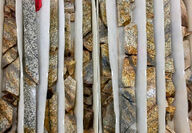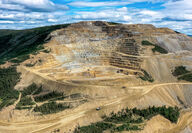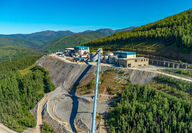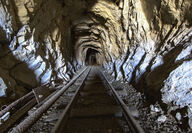Sorted by date Results 26 - 50 of 80

As the White House continues to dole out hundreds of billions of dollars to position America as the global leader in clean energy and digital technologies, Beijing initiates a strategy to put America in check with the global economy equivalent of pawns. These pawns in the technology chess match between the U.S. and China are gallium and germanium, a pair of semiconductor metals used to make the computer chips essential to every facet of modern life. Before all the major news o...

From the Pentagon's multi-million-dollar investment in Graphite One Inc. to China's restrictions on the exports of gallium and germanium, Alaska's current critical minerals supply and future potential was in the headlines and subtext of American news stories over the past month. Alaska as a future source of minerals critical to the clean energy transition grabbed headlines after the mid-July news that the U.S. Department of Defense awarded Graphite One Inc. $37.5 million to...

For those in the know, Alaska's resources aren't just some surprise windfall for renewable energy technologies. While precious metals like gold and silver have been the primary focus of more than a century of mining up north, the 49th State is home to 49 of the 50 materials on the United States' critical minerals list and has a history of stepping up to the plate to provide America with critical minerals when they are needed the most. Looking ahead over the next two to three...

Resolution Minerals Ltd. Aug. 21 announced that it staked a 114-square-mile land package in an area of Alaska prospective for nickel with associated copper, cobalt, and platinum group metals. Australia-based Resolution is best known in Alaska for its exploration of the 64North gold project near Northern Star Resources Ltd.'s Pogo mine. Over the past year, however, the company has also been acquiring and exploring projects that could offer future supplies of the metals needed...

Alaska mining and Washington policy leaders gather to discuss forging a path forward to critical minerals in US's Arctic state. Building upon the discussions and strategic ideas set in motion during the 2022 "Alaska's Minerals: A Strategic National Imperative" summit, the U.S. Department of Energy's Arctic Energy Office co-hosted a two-day summit this week to advance policy recommendations for development of critical mineral resources in the North American Arctic. For the Unit...

ANCHORAGE, Alaska: Gathering together leaders, decision-makers, and experts toward the common goal of understanding the value of Alaska's mineral endowment and how to unlock it for America's net-zero emission goals, the U.S. Department of Energy's Office of Fossil Energy and Carbon Management hosted a two-day workshop bringing attention to carbon management and critical minerals and how the Last Frontier will be a keystone in achieving the country's lofty ambition. Held at...

More gold, strong zinc prices helped push value higher; critical minerals could add a boost moving forward. Alaska mines produced approximately $4.51 billion worth of nonfuel minerals last year, a 16% increase over the $3.89 billion in 2021, and an impressive 42.7% jump over the $3.16 billion of mined products during 2020, according to the U.S. Geological Survey's Mineral Commodity Summaries 2023 report. The rise in Alaska mine production value is largely due to increased...

Supply, demand, and risks to the US supply chain define criticality Metaphorically speaking, critical minerals are not set in stone. Instead, the criticality of these basic building blocks of modern society shifts with the demands for any given mineral, the ability of the mining sector to keep pace with that demand, and the geopolitics of where that supply comes from. "Mineral criticality is not static, but changes over time," said Steven Fortier, director of the National...

Nearly all the 50 minerals critical to the United States can be found at mines, deposits, and prospects across Alaska. Intriguing lithium occurrences, however, have not been identified in America's Last Frontier – until now. Discovery Alaska Ltd. says it has identified lithium at the Coal Creek prospect on its Chulitna property about four miles west of the Parks Highway midway between Anchorage and Fairbanks, Alaska. Discovery acquired the Chulitna property early last year t...

Discovery Alaska Ltd. May 23 reported that its initial scanning with a handheld analyzer identified lithium across the entire length of core from 12 historical holes drilled at the Coal Creek prospect on the company's Chulitna property in Alaska. Situated about four miles west of the Parks Highway, roughly midway between Anchorage and Fairbanks, Alaska, Chulitna is a roughly 77-square-mile property that covers the Partin Creek gold-silver-copper prospect and the Coal Creek...

Alaska mines produced roughly $3.89 billion worth of nonfuel minerals last year, a 23% increase over the estimated $3.16 billion produced in the 49th State during 2020, according to Mineral Commodity Summaries 2022 published by the United States Geological Survey on Jan. 31. The rise in Alaska mine production value is largely due to increased zinc and gold production, along with strong metals prices last year. According to early estimates by the Alaska Division of Geological...

The Association for Mineral Exploration will recognize 11 leaders who have made significant contributions to the mineral exploration and development industry during the AME Roundup 2022. "The AME Celebration of Excellence Awards recognize the achievements of individuals who contribute to successfully finding, funding and building safe and responsible mineral exploration and development projects," explained AME Chair Jill Tsolinas. The 2021 Celebration of Excellence Awards...

With more than half of Alaska's entire population living within its region, Cook Inlet Region Inc., more commonly known as CIRI, is the most metropolitan of the 12 landholding Alaska Native regional corporations. While CIRI has leveraged its urban position with retail developments such as Tikahtnu Commons, an enormous retail and entertainment center on the outskirts of Anchorage, the Southcentral Alaska regional corporation also has oil and gas, renewable energy, and mining...

The global transition to electric vehicles plugged into renewable energy sources is powering enormous demand for graphite, the single largest ingredient in lithium-ion batteries. "Graphite demand increases in both absolute and percentage terms since graphite is needed to build the anodes found in the most commonly deployed automotive, grid, and decentralized batteries," the World Bank penned in a 2020 report, "The Mineral Intensity of the Clean Energy Transition." According...

From the advancements of technology during the Bronze Age to the computers and telecommunication systems of today's Big Data Era, tin has been critical to human progress for at least 5,500 years. Sometime around 3500 BC, Sumerians living in modern day Turkey and Iran discovered that mixing a little tin with copper created bronze, an alloy that produced much more durable weapons and tools than those cast from copper alone. This cutting-edge discovery offered a strategic and...

An unsung war hero that saved countless American troops during World War II, an overlooked battery material that has played a pivotal role in storing electricity for more than 100 years, and a major ingredient in futuristic grid-scale energy storage, antimony is among the most important critical metalloids that most people have never heard of. While antimony may not be part of the common lexicon, humans have been using this semi-metal for more than 5,000 years. "For example,...

Alaska mines produced roughly $3.16 billion worth of non-fuel minerals during 2020, a slight increase over the $3.13 billion during 2019, according to Mineral Commodity Summaries 2021 published by the U.S. Geological Survey on Feb. 2 The rise in Alaska mine production value is largely due to higher gold output at Alaska's large mines and record setting prices for the precious metal last year. According to early estimates by the Alaska Division of Geological & Geophysical...

Cans, cups, roofs, and foil hats are likely the first things that come to mind when thinking about tin – none of which conjure images of a metal that should be considered critical to a modern country like the United States. According to a study carried out by Massachusetts Institute of Technology, however, tin is the metal expected that be most impacted by new technologies. Commissioned by Rio Tinto, the MIT study found that tin beat out more likely technology metals candidate...

The United States imported more than 90% of the 1.4 million metric tons of titanium minerals it consumed during 2019. What the mass majority of this critical mineral was used for, however, may come as a surprise. While titanium's lightweight and extreme durability make it an excellent material for aircraft and high-performance sporting equipment, more than 90% of this mineral mined each year is used to impart a stark whiteness to a surprisingly wide variety of consumer goods w...

While Alaska is regarded as a geological storehouse of minerals critical to the United States, it is less renowned as a current globally significant supplier of germanium, a zinc byproduct metalloid with optical qualities that make it an important ingredient in infrared and fiber-optics, and semiconducting properties being applied to quantum computing, and solar energy systems. "The extensive use of germanium for military and commercial applications has made it a critical...

Alaska mines produced roughly $3.13 billion worth of non-fuel minerals last year, down roughly 9 percent from the US$3.44 billion in 2018, according to Mineral Commodity Summaries 2020, an annual report published by the U.S. Geological Survey on Feb. 6 – the earliest comprehensive source of world mineral production data. The drop in Alaska mine production value is largely due to lower output from the two largest gold mines in the state – Fort Knox and Pogo. According to ear...

With more than half of Alaska's entire population living within its region, Cook Inlet Region Inc., more commonly known as CIRI, is the most metropolitan of the 12 landholding Alaska Native regional corporations. While CIRI has leveraged its urban position with retail developments such as Tikahtnu Commons, an enormous retail and entertainment center on the outskirts of Anchorage, the Southcentral Alaska regional corporation also has oil and gas, renewable energy and mining...

While mining activity remained strong in the Northwest Territories in 2019, industry and government officials alike worried that the robust sector, driven largely by production at three diamond mines, has entered a prolonged downward slide. The near-term economic outlook for the territory, which covers 1.3 million square kilometers in Canada's central Arctic region, continues to be bleak as its diamond mines that have now passed peak production and replacement projects are in...

Titanium conjures images of the durable and lightweight metal used to build aircraft, replacement hips, high-end bicycle frames and even quality golf clubs. While its outstanding weight-to-strength ratio and corrosion resistance makes this critical metal ideal for these applications, roughly 93 percent of the world's titanium is used to impart a stark whiteness to many of the consumer goods we use every day. "Titanium is different than most other metallic elements in that it...

A vital ingredient in stainless steel and superalloys, chromium is considered by the United States Geological Survey as "one of the nation's most important strategic and critical materials." "Because there is no viable substitute for chromium in the production of stainless steel and because the United States has small chromium resources, there has been concern about domestic supply during every national military emergency since World War I," the USGS explains. Rich chromite...